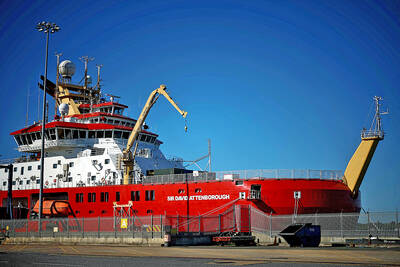NASA’s Kepler space telescope has discovered five new planets beyond the solar system, the US space agency said on Monday, just 10 months after Kepler launched into space to find Earth-like planets.
The discovery of the five exoplanets “contributes to our understanding of how planetary systems form and evolve from the gas and dust disks that give rise to both the stars and their planets,” NASA’s William Borucki, principal science investigator for the Kepler mission, said in a statement.
But all five exoplanets are “too hot for life as we know it,” NASA said.
The newly discovered planets are known as “hot Jupiters” because of their large masses and extreme temperatures, which range from 1,204°C to 1,649°C — hotter than molten lava.
Their orbits last between three and five days, meaning they follow paths close to their stars, which are hotter and larger than the Earth’s sun, NASA said.
The smallest of the newly discovered planets is roughly the size of Neptune, the fourth largest planet in Earth’s solar system, and the biggest is around the size of Jupiter, the largest planet in our solar system. One of the planets, which have been given the unimaginative names of Kepler 4b, 5b, 6b, 7b and 8b, is similar in many ways to Neptune, although its irradiation level is much higher.
Another planet is one of the least dense ever discovered, and along with the other three, confirms the existence of planets with densities substantially lower than those predicted for gas giant planets. The five exoplanets were among discoveries made by the Kepler space telescope in the first six weeks after it became operational in May last year. Borucki presented the early discoveries and other findings at a meeting of the American Astronomical Society in Washington on Monday.
Kepler looks for the signatures of planets by measuring dips in a star’s brightness which are caused by planets crossing in front of them and periodically blocking out part of the starlight.
The size of the planet can be derived from the size of the dip in brightness while the temperature can be estimated from the characteristics of the star it orbits and the planet’s orbital period.
Kepler is NASA’s first mission in search of Earth-like planets orbiting suns similar to ours.
It launched in March last year, equipped with the largest camera ever sent into space — a 95-megapixel array of charge-coupled devices — and is expected to continue sending information back to Earth until at least November 2012.
It is searching for planets as small as Earth, including those orbiting stars in a warm, habitable zone where liquid water could exist on the surface of the planet.
“The Kepler observations will tell us whether there are many stars with planets that could harbor life or whether we might be alone in our galaxy,” Borucki said.

STEPPING UP: Diminished US polar science presence mean opportunities for the UK and other countries, although China or Russia might also fill that gap, a researcher said The UK’s flagship polar research vessel is to head to Antarctica next week to help advance dozens of climate change-linked science projects, as Western nations spearhead studies there while the US withdraws. The RRS Sir David Attenborough, a state-of-the-art ship named after the renowned British naturalist, would aid research on everything from “hunting underwater tsunamis” to tracking glacier melt and whale populations. Operated by the British Antarctic Survey (BAS), the country’s polar research institute, the 15,000-tonne icebreaker — boasting a helipad, and various laboratories and gadgetry — is pivotal to the UK’s efforts to assess climate change’s impact there. “The saying goes

Floods on Sunday trapped people in vehicles and homes in Spain as torrential rain drenched the northeastern Catalonia region, a day after downpours unleashed travel chaos on the Mediterranean island of Ibiza. Local media shared videos of roaring torrents of brown water tearing through streets and submerging vehicles. National weather agency AEMET decreed the highest red alert in the province of Tarragona, warning of 180mm of rain in 12 hours in the Ebro River delta. Catalan fire service spokesman Oriol Corbella told reporters people had been caught by surprise, with people trapped “inside vehicles, in buildings, on ground floors.” Santa Barbara Mayor Josep Lluis

Police in China detained dozens of pastors of one of its largest underground churches over the weekend, a church spokesperson and relatives said, in the biggest crackdown on Christians since 2018. The detentions, which come amid renewed China-US tensions after Beijing dramatically expanded rare earth export controls last week, drew condemnation from US Secretary of State Marco Rubio, who on Sunday called for the immediate release of the pastors. Pastor Jin Mingri (金明日), founder of Zion Church, an unofficial “house church” not sanctioned by the Chinese government, was detained at his home in the southern city of Beihai on Friday evening, said

TICKING CLOCK: A path to a budget agreement was still possible, the president’s office said, as a debate on reversing an increase of the pension age carries on French President Emmanuel Macron yesterday was racing to find a new prime minister within a two-day deadline after the resignation of outgoing French Prime Minister Sebastien Lecornu tipped the country deeper into political crisis. The presidency late on Wednesday said that Macron would name a new prime minister within 48 hours, indicating that the appointment would come by this evening at the latest. Lecornu told French television in an interview that he expected a new prime minister to be named — rather than early legislative elections or Macron’s resignation — to resolve the crisis. The developments were the latest twists in three tumultuous